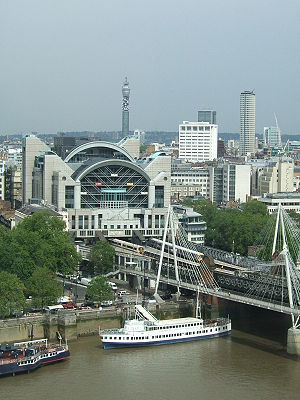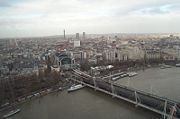Charing Cross railway station
 |
|
| Location | Charing Cross |
|---|---|
| Local authority | Westminster |
| Managed by | Network Rail |
| Station code | CHX |
| Platforms in use | 6 |
| Travelcard zone | 1 |
| NR 2004/5 usage | 28.822 million[1] |
| NR 2005/6 usage | 28.562 million[1] |
| NR 2006/7 usage | 34.779 million[1] |
|
|
|
| 1864 | Opened |
|
|
|
| List of stations | Underground • National Rail |
| External links | Departures • Facilities |
|
|
|



Charing Cross railway station is a central London railway terminus. It is unusual among London's railway termini in that its services connect it to two of the others, Waterloo (via Waterloo East) and London Bridge. It is one of 17 stations managed by Network Rail, and trains serving it are operated by Southeastern and Southern. It is the fifth busiest rail terminal in London.
The station takes its name from its location next to the central London road junction of Charing Cross. The front of the station faces The Strand, while at the other end is the northern end of Hungerford Bridge, which is crossed by all trains serving the station.
Contents |
History
The original station building was built on the site of the Hungerford Market by the South Eastern Railway and opened on 11 January 1864. The station was designed by Sir John Hawkshaw, with a single span wrought iron roof arching over the six platforms on its relatively cramped site. The curve of the original roof design can still be seen on the interior brickwork. A year later the Charing Cross Hotel, designed by Edward Middleton Barry, opened on 15 May 1865 and gave the station an ornate frontage in the French Renaissance style. At the same time, a replica of the Eleanor Cross was erected in the station forecourt, based on the original 13th century Whitehall Cross that had been demolished in 1647. Distances in London are officially measured from the original site of the cross in Whitehall, now the statue of Charles I, and not from this replica cross.
The elegant original roof structure collapsed on 5 December 1905. By great fortune, only six lives were lost (two workmen on the roof, a bookstall vendor and three passers-by in the street, where most of the girders fell) as the collapse happened outside the rush hour and was sufficiently gradual for the station platforms to be evacuated. An enormous travelling timber gantry had to be constructed to take the remainder of the station roof down safely. The roof was replaced by a utilitarian post and girder structure supporting a ridge and furrow roof. The station was re-opened on 19 March 1906.
Following bomb damage in World War II, the elaborate Mansard roof of the upper floors of the hotel was rebuilt in a plain neo-Georgian white brick.
In 1990 most of the area over the platforms was covered by Embankment Place, a post-modern office and shopping complex designed by Terry Farrell and Partners. A majority of this complex is currently occupied by PricewaterhouseCoopers.
Services
There are 33 train departures per hour off-peak during the week.
Operated by Southeastern:
- 2 to Hastings
- 2 to Tunbridge Wells
- 4 to Ashford International
- 2 split at Ashford International, then:
- 2 to Ramsgate
- 1 to Dover Priory
- 1 to Margate
- 2 split at Ashford International, then:
- 5 to Orpington
- 4 to Gravesend
- 2 to Gillingham
- 6 to Dartford
- 2 to Hayes
- 5 to Sevenoaks
Operated by Southern:
- 2 to Tattenham Corner
| Preceding station | National Rail | Following station | ||
|---|---|---|---|---|
| Terminus | Southern Caterham Line Tattenham Corner Line |
London Waterloo East | ||
| Southeastern South Eastern Main Line |
||||

Connections
Charing Cross is served by two London Underground stations, one at each end: Charing Cross, and Embankment. Originally Embankment was called Charing Cross, while the present Charing Cross was Trafalgar Square (Bakerloo line) and Strand (Northern line) stations, combining under the new name when connected by the new Jubilee Line station in 1979. The change of name acknowledged that Strand and Trafalgar Square were closer to the station than Embankment. Note that additionally, for a short time, the stations were signed as "Charing Cross Embankment" and "Charing Cross Strand". The Jubilee line platforms are no longer served, following the 1999 extension of the line in which it was diverted to Westminster and onwards south of the river Thames.
External links
- Station information on Charing Cross railway station from Network Rail
|
|||||||||||